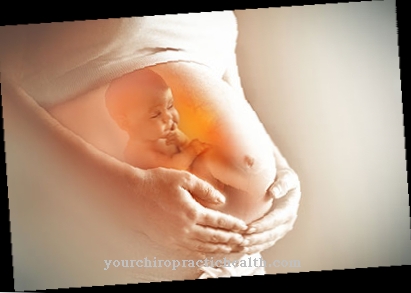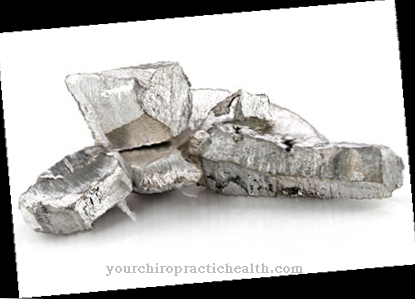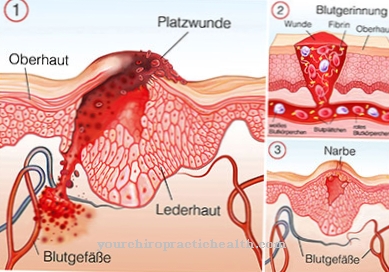After falling on your arm or shoulder, you should Upper arm fracture should be considered if there is an additional restriction of movement in addition to severe pain. Older people in particular belong to the risk group for this fracture.
What is an upper arm fracture?

© logo3in1 - stock.adobe.com
A break just below the head of the humerus is called a subcapital humeral fracture designated. Usually the head of the humerus is also affected with this type of humerus fracture. These fractures are relatively common after accidents or falls. The patients fall on their shoulders or on their outstretched arm.
The humerus is narrow at this point and also less hard than in other places and can therefore break more easily. If osteoporosis is present in addition to the accident, there is an increasing risk of this fracture. If an upper arm fracture occurs without external influences, a metastasis or a tumor may be the cause of the injury.
causes
The cause of one Upper arm fracture (subcapital humerus fracture) is the force exerted on the shoulder or the outstretched arm during an accident or fall.
Athletes injure themselves while cycling or motorcycling, but falling while riding or skiing can also lead to this fracture.
Older people are also often affected by a fracture of the upper arm due to their increasing insecurity when walking and the resulting falls and possibly additional osteoporosis.
The group of 60 to 80-year-old women in particular suffer from this fracture twice as often as men of the same age.
Symptoms, ailments & signs
A fracture of the upper arm is associated with clear and typical symptoms, so that self-diagnosis is often very easy. In most cases, there is severe swelling associated with a broken upper arm, which is clearly visible. Of course, this is also associated with considerable pain, so that the entire sequence of movements is very restricted.
There may even be an open fracture. In such a case, the fracture of the bone can be seen with the naked eye. Of course, an open hernia should receive medical and medicinal treatment. In some cases, surgery is even necessary to straighten the bones and allow a smooth healing process. However, one also speaks of an upper arm fracture if there is a small hairline crack.
A hairline crack is a very small crack in the bone that causes significantly less pain than a fracture. However, such a small crack in the humerus also causes pain that can last for a very long time. Affected people often only suspect tension or muscle strain.
In many cases, a hairline crack in the upper arm grows back together very quickly, so that no medical treatment is necessary. However, if typical symptoms such as swelling and bruises occur, a doctor should be consulted as soon as possible.
Diagnosis & course
A Upper arm fracture is usually noticeable through restricted movement of the shoulder or arm and severe pain. The injured tissue swells noticeably and the arm is held against the body in a relieving position. D.
The fall can also lead to the development of a large bruise on the patient's shoulder and / or armpit and on the side of the patient's chest. It can appear after a few hours or the next day. An affected patient will see a doctor simply because of these complaints. After a detailed anamnesis discussion, he can make a reliable diagnosis through several x-rays.
If it is suspected that the cause of the break is to be found in a tumor, an MRI (magnetic resonance imaging) examination is also performed. Depending on the accident situation, it may be necessary to rule out that ligaments were affected or that the shoulder was dislocated next to the fracture of the upper arm. Computed tomography (CT) is used for this.
Complications
Complications due to an upper arm fracture are rarely to be feared. The chances of recovery are considered good with both conservative and surgical therapy. Even greater restrictions on movement usually only occur in individual cases.
One of the immediate consequences of a humeral fracture is hypovolemic shock. This is what we talk about when the circulating blood is rapidly declining. This in turn threatens the injured person to faint. Another conceivable complication is the formation of thrombophlebitis. Blood clots form, which block the arteries.
The thrombi also harbor the risk of pulmonary embolism. If parts of the thrombus become detached, there is a risk that they will penetrate the circulation and block arteries there. The risk of sequelae is greatest if the fracture of the upper arm occurs in the area of the shoulder blade and collarbone.
If, on the other hand, the fracture occurs in the area of the elbow, the risk of complications is lower. Injury can also affect arteries, muscles, and nerves. Pseudarthrosis is a late consequence of the humerus fracture. During this process, the bone does not consolidate correctly. A fibrous callus can also develop.
If the upper arm fracture is treated surgically, there are also risks. These include blood clots, bruises, infections, and bleeding. If nerves are injured, this can lead to sensory disorders or paralysis. Furthermore, allergies to implants can occur.
When should you go to the doctor?
If the person concerned suffers from pain in the arm or severe restrictions on mobility after a fall or accident, a doctor is required. You should refrain from taking pain medication yourself until you have consulted a doctor. If the shoulders or arms can no longer be moved as usual, medical care is required.
Swelling on the arm, discoloration of the skin and sensory disorders must be examined and treated. Bruises, tension or deformation of the skeletal system are signs of an irregularity that must be discussed with a doctor. If the physical exercise capacity decreases, the gripping function of the fingers can no longer be performed or abnormal heart rhythm occurs, a visit to the doctor is advisable.
If everyday tasks or usual sporting activities can no longer be carried out, there is a need for action. Sensitivity to pressure in the arm and shoulder, numbness or hypersensitivity to perceived stimuli are further signs of impaired health.
A doctor's visit is necessary because medical help should be initiated as quickly as possible for an optimal healing process in the case of a broken upper arm. Changes in behavior, a whiny appearance in children and withdrawal can be further indications of an irregularity. If the pain continues to spread or the body's ability to withstand stress decreases further, the person concerned needs a comprehensive medical examination.
Treatment & Therapy
About 80 percent of patients can have a Upper arm fracture treated without surgery. For this purpose, the arm is provided with a special bandage, the so-called Gilchrist or Desault bandage, or a splint and thereby immobilized for about two weeks.
It is important to restore mobility at an early stage through physiotherapy applications. If the bone is broken into several parts, however, surgical treatment must be carried out. The same applies if blood vessels or nerves have been damaged or there is a threat of damage as a result. At the beginning of the operation, the fracture is first straightened under X-ray control. At this point the patient is already under anesthesia.
The bone is then stabilized with screws, wires or plates. Which surgical method is used is determined by the severity of the fracture. As soon as healing has progressed and the pain has subsided, mobility must be restored through physiotherapy. The materials introduced during the operation must be removed again after a while. This is now often possible through the smallest incisions or endoscopically.
Outlook & forecast
A general statement on the prognosis of upper arm fractures is difficult and depends heavily on the type and location of the fracture, the treatment method and start, as well as the patient's age and any previous illnesses. Put simply, simple fractures with correct and timely treatment have a good chance of uncomplicated healing with complete or almost complete restoration of the function of the affected arm.
In the event of a surgical treatment, foreign material (plates, screws) that have been introduced can often remain in the body for life without any problems, so that follow-up operations and metal removals can often be omitted.
However, if a complicated fracture form, individual previous illnesses (e.g. osteoporosis, circulatory disorders, nicotine consumption, etc.) or incorrect follow-up treatment (e.g. too early or incorrect load build-up) make the healing process more difficult, permanent consequential damage such as pain, restricted mobility and / or misalignment are possible. An extended duration of treatment and possibly further surgical measures could then be necessary.
In these cases, however, complete freedom from symptoms cannot always be achieved even after conserving conservative and operative options. Early and professional treatment as well as adequate physiotherapeutic care are decisive prerequisites for the most complication-free course possible.
prevention
One Upper arm fracture can hardly be prevented by active measures, as the risk generally increases with age. However, it is important to counteract the early onset of osteoporosis, as this disease further promotes such fractures. This includes sufficient exercise and a diet rich in calcium. It has also been proven that maintaining general mobility, especially in old age, considerably reduces the risk of falling and thus the likelihood of suffering a fracture of the upper arm.
Aftercare
Follow-up care assumes that symptoms actually have to be alleviated. This is what we know from cancer, for example. The medical staff use imaging techniques to research new tumors. A broken upper arm, on the other hand, does not require such follow-up care.
As a rule, there are no functional restrictions for the upper arm after therapy. Due to the freedom from symptoms, there is no justification for regular x-rays. If, on the other hand, there is a complicated hernia and other accompanying circumstances such as old age or a weakened immune system, the healing period is extended. This makes follow-up care necessary for months.
Doctor and patient agree on a regular appointment. Imaging procedures such as x-rays or ultrasound examinations provide clarity about the healing progress. If necessary, a physiotherapist will be called in. Follow-up care also aims to prevent the symptoms from recurring.
For the upper arm fracture, this means that a corresponding fracture must not occur. However, this cannot be the responsibility of a doctor because the effects of violence occur in the context of unforeseeable accidents. A doctor therefore advises a sick person to avoid certain risk activities. The responsibility for this lies in the sole responsibility of the patient.
You can do that yourself
In the event of a broken upper arm, the affected person should take sufficient care of himself. Carrying heavy objects, performing sporting activities or exerting yourself are prohibited. Movements should be performed slowly and calmly, especially at the beginning of the healing process, so that there are no complications. In the case of a broken upper arm, the arm is often fixed and immobilized. Therefore, a restructuring of everyday life is necessary.
Daily work and processes are to be carried out with the sound arm or should be carried out by people in the immediate vicinity. In special cases, the patient can hire a nursing service to get adequate support. Stress and hectic rush should be avoided when doing everyday things.
In addition, the patient helps himself if he does not allow mental stress to arise or if he relieves it by using mental relaxation techniques. To prevent tension, light balancing movements should be performed several times a day. In addition, the organism must be supplied with sufficient heat so that any muscle hardening can be broken down.
During the healing process, the body needs sufficient vitamins, minerals and trace elements. With a healthy and balanced diet, the patient can strengthen his immune system and thus promote recovery. Towards the end of the treatment, given the physical possibilities, start building muscle and increasing the range of motion.



.jpg)




















.jpg)



